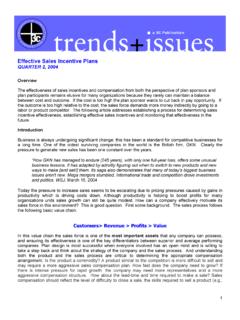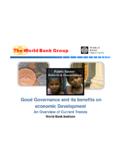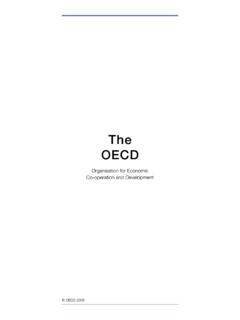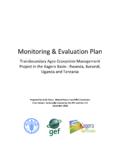Transcription of The Role of the Private Sector in the Context of Aid ...
1 The Role of the Private Sector in the Context of Aid effectiveness Consultative Findings Document Final report, 2 February 2011 Penny Davies, Consultant 1 TABLE OF CONTENTS LIST OF ACRONYMS 1. INTRODUCTION 3 The role of the Private Sector in the Context of aid effectiveness 3 Purpose and methodology 3 Structure of the report 4 2. THE ROLE OF THE Private Sector IN AID AND development 4 Private Sector impact on development opportunities and challenges 4 What are the incentives for Private Sector engagement in development processes at country level and how is engagement manifested? 5 From addressing risk towards exploring business opportunities From philanthropy towards core business models Towards new types of inclusive business models What role should the Private Sector play in aid processes?
2 10 Opportunities and challenges for aid effectiveness How to engage the Private Sector in the aid effectiveness agenda? 3. PARTNER COUNTRY PRIORITIES AND CHALLENGES 15 4. THE ROLE OF DONORS AND AID 17 Objectives and strategies of donors 17 What role should aid play and are donors well equipped? 18 5. THE ROLE OF AND POTENTIAL FOR PARTNERSHIPS 24 Public- Private partnerships (PPPs) to address development challenges 24 What are the conditions for effective contributions of PPPs to development objectives? 25 6. MEASURING RESULTS 27 Does the Private Sector measure development impacts? 27 How do donor and partner countries measure results of Private Sector engagement?
3 28 7. SUGGESTIONS FOR WAYS FORWARD 29 8. REFERENCES 34 ANNEXES ANNEX 1: GUIDING QUESTIONS FOR INTERVIEWS 37 ANNEX 2: LIST OF CONDUCTED INTERVIEWS 38 ANNEX 3: LIST OF BOXES 40 ANNEX 4: THE PARIS DECLARATION AND ACCRA AGENDA FOR ACTION PRINCIPLES 41 ANNEX 5: Private Sector IMPACT ON development OPPORTUNITIES AND CHALLENGES 42 ANNEX 6: DAC MEMBERS TOTAL NET RESOURCE FLOWS TO DEVELOPING COUNTRIES 44 2 LIST OF ACRONYMS AAA Accra Agenda for Action BCtA Business Call to Action BOP Base of the Pyramid CEO Chief Executive Officer CSO Civil Society Organisation CSR Corporate Social Responsibility DAC development Assistance Committee of the OECD DCED Donor Committee for Enterprise development GFATM Global Fund to Fight AIDS Tuberculosis and Malaria GRI Global Reporting Initiative HLF 4 Fourth High Level Forum on Aid effectiveness IFC International Finance Corporation of the World Bank MDB Multilateral development Bank MDG Millennium development Goals MNC Multinational Corporation NEPAD New
4 Partnership for Africa's development NGO Non Governmental Organisation ODA Official development Assistance OECD Organisation for Economic Co-operation and development PPP Public- Private Partnership SME Small and Medium Enterprise UNDP United Nations development Program WBCSD World Business Council for Sustainable development WP-EFF Working Party on Aid effectiveness 3 1. INTRODUCTION The role of the Private Sector in the Context of aid effectiveness The Working Party on Aid effectiveness hosted by the OECD development Assistance Committee (DAC), has initiated a work stream to look at The role of the Private Sector in the Context of Aid effectiveness ahead of the 4th High Level Forum on Aid effectiveness (HLF 4) to take place in Busan, Korea, 29 November-1 December, 2011.
5 Contributions from the Private Sector to the development process in developing countries are becoming more significant: Private Sector stakeholders Private foundations and for-profit Private Sector - are contributing with development funding and sharing of experiences, including in aid Donors have increased their engagement with the for-profit Private Sector to catalyse contributions to development objectives. Likewise, partner countries are recognising the Private Sector in national poverty reduction and development plans. New collaborations are forged, most notably so called public- Private partnerships (PPPs), to combine the strengths of different stakeholders.
6 Whilst there are plenty of initiatives focussing on the role of the Private Sector in development , there has been less focus on the Private Sector in the Context of aid effectiveness . There are limited references to the Private Sector in the Paris Declaration on Aid effectiveness (2005) and the subsequent Accra Agenda for Action (2008), the two international agreements on aid effectiveness which over one hundred countries and institutions have adhered to (Annex 4). The Working Party on Aid effectiveness (WP-EFF) has as of yet had limited contacts with the Private Sector but is increasingly eager to discuss and monitor aid effectiveness in a broader Context which includes non-government actors and non-official providers of funding for development .
7 This change is encouraged by the OECD DAC and its growing interest in non-Official development Assistance (ODA) flows and synergies between ODA and other sources of development funding. The work stream on The role of the Private Sector in the Context of Aid effectiveness responds to an identified need by the WP-EFF to explore the interface between the role of the Private Sector and aid effectiveness , with the objective to enrich and provide added value to the aid effectiveness agenda ahead of HLF 4. Purpose and methodology The purpose of this report is to identify and summarise lessons learned, opportunities and challenges in relation to the role of the Private Sector in the Context of aid effectiveness .
8 The report will serve as an input to the discussions and decisions ahead of and at HLF 4, as well as to general discussions on the evolving global aid architecture. The report was commissioned by the Aid effectiveness Division of the development Co-operation Directorate of the OECD-DAC Secretariat and was put together by an external consultant. The main target group of the report is the Working Party on Aid effectiveness . The document is based on 47 qualitative interviews with different stakeholders: donors, Private Sector representatives (for-profit and Private foundations), partner countries, civil society organisations and independent experts (Annex 2). Viewpoints frequently differed between and within categories of stakeholders.
9 The document seeks to reflect the different perspectives. Individual responses are quoted in the report to illustrate some of the issues raised but interviewees remain anonymous. The questions which provided guidance to the interviews are listed in Annex 1 1 See figures on resource flows in Annex 6. 4 and the names and affiliations of respondents are listed in Annex Interviewees were given the possibility to comment on a draft version of the report in order to clarify any eventual misunderstandings or add any points not sufficiently reflected. The Private Sector is a broad term which encompasses a range of diverse actors and the definitions vary.
10 In this work stream, the idea was to explore both the for-profit Private Sector and Private foundations where relevant. However, most respondents focussed on the role of the for-profit Private Sector and stressed the need to distinguish between the role of Private foundations and the for profit- Private Sector , as the former operate on a non-profit basis often in ways similar to donors or civil society organisations. It is recognised that the for-profit Private Sector is very heterogeneous. To the extent possible, the different types of for-profit Private Sector , as referred to by respondents, are highlighted in the document. Structure of the report The report is based on the logic of the questionnaire and what interviewees chose to focus on.

















